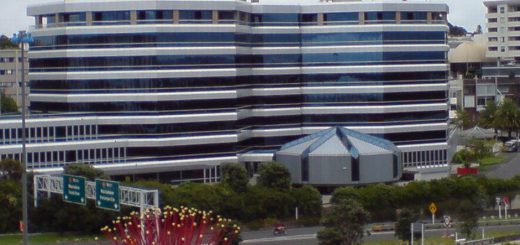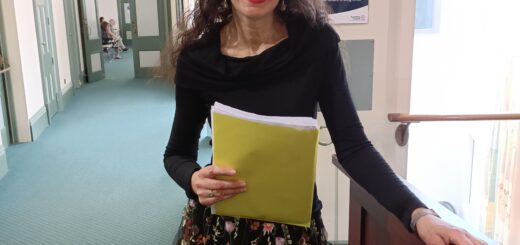My submission before Auckland Council’s independent commissioners against ‘Healthy Waters’ discharge of sewage into the harbour
BEFORE THE INDEPENDENT COMMISSIONERS
ON BEHALF OF AUCKLAND COUNCIL
IN THE MATTER of s88 of the Resource Management Act 1991
AND
IN THE MATTER of Application BUN60319388 by Healthy Waters, Auckland Council for resource consents for the construction of infrastructure at 94 Shelly Beach Road and elsewhere, for the “St Mary’s Bay/Masefield Beach Water Quality Improvement Project”
SUBMISSION BY MICHAEL LEE
26 September 2018
Introduction
- My name is Michael Lee. I am the Auckland councillor for Waitematā & Gulf. As a member of the Governing Body of Auckland Council (ARC) and as a member of the former Auckland Regional Council I have represented this area from February 1992 up until the present time; from (2004-2010) as the chairman of the Auckland Regional Council. During my 26 years in regional government, and before I have taken a keen interest in issues relating to the Hauraki Gulf and the Waitemata Harbour, especially environmental issues. I hold a Master of Science degree (hons) in Biological Sciences from Auckland University and this included credits in Resource Management Law.
- I was elected to the ARC six month or so after the enactment of the Resource Management Act (1991) and soon after which I became actively involved in the preparation of the first Auckland Regional Coastal Plan and the first Auckland Regional Policy Statement. Updated versions of these have been incorporated into the Auckland Unitary Plan under which this application is being processed. From 1997 to 2003 I also spent six years working as a contractor for Watercare Services, most of that time involved in public communications and community liaison for Project Manukau, the upgrade of the Mangere Wastewater Treatment Plant.
- I present today in support of the submissions of the St Marys Bay Association, the Herne Bay Residents Association, the Western Bays Community Group, SASOC and other citizens who have raised serious concerns about this particular ‘Healthy Waters’ consent application.
- The issue of sewage contaminated storm water being discharged into the Waitemata harbour, is not a new issue. Historically, around the middle of the last century the matter of sewage discharges into Auckland Harbour became highly controversial and the subject of a bitter and long running public dispute. I refer of course to the Browns Island affair (c1940 -1955) a plan for Auckland’s sewage outfall on that island discharging into the inner Gulf set officialdom against the wider Auckland public. The dispute was only settled when one of the leading public opponents Dove Myer Robinson and his supporters, members of the ‘Auckland & Suburban Drainage League’, were elected to the then Auckland Metropolitan Drainage Board, whereupon signed contracts were torn up, construction work already underway was halted and a completely and quite radically different solution was embarked upon – fortunately, very successfully as it turned out. In that case the judgement of history reveals the official experts got it very badly wrong – and the citizens were proven to be right.
- History is unlikely to repeat in our own more enlightened, environmentally sensitive era. However, despite great advances in scientific knowledge and the passage of enlightened environmental legislation like the Resource Management Act, human nature has not changed. There are historical resonances in Auckland’s present situation which we all should be mindful of.
- While planned reticulated sewage discharges into the harbour would nowadays be unthinkable, the unprecedented population growth in Auckland, and the intensification of central Auckland, has seen a significant increase in the volume of wastewater overflows from our antiquated Combined Sewer system into the Waitemata Harbour. Especially so in the oldest, historic parts of Auckland including the western bays, (St Marys and Herne Bays) the area of this consent application.
- At least 25 years ago, and especially after the advent of the Resource Management Act, the former Auckland City Council made it clear it was aware of the problem and resolved to deal with it. And so it did. Auckland City through its CCO Metrowater, taking the international best practice approach, began methodically separating wastewater from stormwater in the older parts of Auckland. Auckland City ratepayers paid an extra rate component to fund this work and residents themselves, especially in the western bays area were required to pay for separation of stormwater and sewage lines on their own properties in order to be ready to link up with the promised new system, as Mr Dirk Hudig of HBRA reminded the commission in his submission. This below-ground retro-fitting work largely went on ‘below the radar’ as it were.
- With the advent of the Auckland Super City amalgamation in 2010, Metrowater was folded into Watercare with its stormwater role going to the new Auckland Council. In its early years, the new council focussed its main concerns on transport and housing and regulatory matters such as the Auckland Plan and the Auckland Unitary Plan. Without any formal political decision, the ‘below the radar’ separation work was by and large stopped –with little or no political or public awareness.
- This all changed in the wake of the Unitary Plan in 2016, specifically in reaction to local impacts of the intensification provisions of the Unitary Plan, and also the parallel Housing Accord Special Housing Areas Act (HASHA) legislation with its Special Housing Areas (SHAs). SHA residential developments were actually signed off by the cabinet without the knowledge, let alone consent, of affected neighbours. Many of these intensive residential developments were located in the inner city, some in historic character areas which happen to be over the Combined Sewer system. In April 2016 I wrote to the Minister of Housing Nick Smith on behalf of the residents of Kelmarna Avenue, Herne Bay who were concerned about such an intensive development in their street. I pointed out that to the Minister that despite this SHA by-passing the Resource Management Act, in terms of the limited wastewater capacity in this locality it was arguably in breach of the ‘sufficient infrastructure’ section 16 (3) of the HASHA Act, and therefore requested it be processed through the RMA. In response the Minister personally attacked me in rather colourful terms on prime time TV.
- Thanks to citizen researchers and widespread media coverage, the old issue of sewage in our harbour re-emerged to become a subject of renewed public awareness and concern. It was quite a shock for many Aucklanders to learn that the western bays area alone had 200 wastewater overflow points and that these overflowed virtually every time it rained i.e.on average 50 or so times a year. On this basis Watercare estimated in 2012 that 2.2 million cubic metres of sewage-contaminated stormwater was discharging into the inner Waitemata harbour every year. Auckland Council’s ‘Healthy Waters’ ‘Safeswim’ programme, designed to inform and reassure the Auckland public actually served to reveal just how often our beaches were unsafe to swim. Then around the same time, early in 2017 a fatal outbreak of typhoid, normally thought to be a Third World disease caused by poor public sanitation, further reinforced public concerns.
- All of this contributed in early 2017 to the formation of the public lobby group SASOC, ‘Stop Auckland Sewage Overflows Coalition’ (an interesting echo of Dove Myer Robinson’s ‘Auckland & Suburban Drainage League’) which retired judge, David Abbott and Mr Dirk Hudig referred to in their submissions. The official response, thanks also to some refreshingly honest comments from Watercare CEO Raveen Jaduram, in a matter of weeks moved from denial to frank admission that there was a serious problem that needed to be dealt with. Part of this official response is the Western Isthmus Water Quality Improvement Programme (WIWQIP). In 2018 Mayor Goff supported by Auckland councillors successfully promoted a targeted rate designed to raise $452m over ten years to help deal with the problem. Auckland ratepayers are now paying this targeted rate. Watercare also announced it would commence in 2019 construction of the long awaited Central Interceptor designed to carry city’s increased wastewater load to the Mangere Water Treatment Plant.
- In terms of public funding, commissioners should also be aware that while work on the Central Interceptor (CI) is due to commence, funding for it remains problematic. Auckland Council is worried that borrowing for the $1.2bn project will mean the council will exceed its debt limit and therefore lead to a downgrade of the council’s international credit rating and a consequent rise in interest payments. The government is being asked to facilitate a legislation change to enable the establishment of a ‘Special Purpose Vehicle’ which will be authorised to borrow the money and separately bill Auckland ratepayers to service the loan and repay the principal for the CI. This and the wider question of funding remains politically fraught and uncertain.
- It is important for commissioners to be also aware of the still unsettled debate between Council ‘Healthy Waters’ and Watercare about the strategic purpose and capacity of the Central Interceptor. Watercare, while acknowledging there is capacity for the CI to take wastewater and stormwater for up to 15 years, strongly advocates for resuming the halted separation of stormwater and wastewater programme as the best long-term solution. ‘Healthy Waters’ on the other hand, has, at least up until now, has argued equally forcefully against the separation approach, claiming the CI can and should carry both wastewater and stormwater.
- In terms of a sustainable strategic solution the St Marys Bay – Masefield Beach project is neither separation of wastewater and stormwater systems, nor does it constitute a viable component of the Central Interceptor. It is simply a diversion and storage system for sewage contaminated storm water which will either be pumped back into the already overloaded Combined System, or failing that, discharged into the harbour.
- This brings me to the crux of my concerns. I believe the Masefield Beach Improvement Project which was originally conceived as a temporary fix, a diversion of unwanted pollutants from one part of the harbour to another, in other words out of Westhaven Marina, given its rising costs, from $10m to $44m so far, and its environmental effects, including effects on the Waitemata Harbour and Hauraki Gulf, is not strategically coherent, nor is it wise use of limited public funding; or rather I should say it is not ‘sustainable’. Not sustainable in terms of the definition of that word in the Purposes and Principles of the Resource Management Act (1991) – nor the provisions of the Hauraki Gulf Marine Park Act (2000).
- Given this is a RMA hearing I would seek the Commissioners’ indulgence to remind ourselves of what is meant by ‘sustainable’ in terms of the RMA. (s5). “In this Act sustainable management means managing the use, development, and protection of natural and physical resources in a way, or at a rate, which enables people and communities to provide for their social, economic, and cultural well-being and for their health and safety while – (a) sustaining the potential of natural and physical resources (excluding minerals) to meet the reasonably foreseeable needs of future generations; and (b) safeguarding the life supporting capacity of air, water, soil and ecosystems; and (c) avoiding, remedying, or mitigating any adverse effects of activities on the environment.”
- ‘Healthy Waters’ has argued that there should be no consideration of the effects of the planned ongoing, 20 times per year (which if correct must increase over time with the growth of Auckland), discharge of sewage contaminated stormwater into the harbour, nor where the plume would actually go. ‘Healthy Waters’ concern to remove this significant environmental effect from consideration is tactically understandable but not within the spirit, the principles and purposes of the Resource Management Act. I note the St Marys Bay Association has challenged the technical legality of ‘Healthy Waters’’ proposed use of the Watercare Network Discharge Consent. I am sure commissioners will be seeking advice on this point and also the challenge in regard to the need for an odour discharge consent. What cannot be removed from consideration however is the 450m, nearly half kilometre long, industrial trench involving the displacement of 2,900 cubic metres of material, to be carved out of the seabed of the Waitemata Harbour. (Nor as other submitters have pointed out the intrusion upon reserve land in an inner city suburb already lacking in public recreation space).
- It is timely then to remind ourselves that this seabed is explicitly part of Hauraki Gulf Marine Park, according to s33 (2) (c) of the Hauraki Gulf Marine Park Act (HGMP) (2001).
- The Hauraki Gulf is a national marine park. One can imagine the outcry if a council department tried to bulldoze a half kilometre long trench through a national park, or even a regional park for that matter.
- In regard to the HGMPA, I would remind the commission that the RMA is not the only Act to be considered in weighing approval or otherwise of this application. I refer to section 7 and section 8 of the HGMPA which together according to s9 and s10 of that Act, constitute both a National Policy Statement and a NZ Coastal Policy Statement.
- Rather than just ‘avoiding, remedying and mitigating’ any adverse effects on the environment required by the RMA, the HGMPA goes one step further with sections 8 (a), (b), (c), (d) all requiring (in this example s8 (a)) ‘the protection and where appropriate, the enhancement of the life-supporting capacity of the environments of the Hauraki gulf, its island and catchments’.
- In case of any doubt, the Act further declares in s13. Obligation to have particular regard to sections 7 and 8. Except as provided in sections 9 and 12, in order to achieve the purpose of this Act, all persons exercising powers or carrying out functions for the Hauraki Gulf under any Act specified in Schedule 1, must in addition to any other requirement specified in those Acts for the exercise of that power or the carrying out of that function, have particular regard to the provisions of sections 7 and 8 of this Act’.
- Rather than meeting the requirements of the Hauraki Gulf Marine Park Act, the 450m long trench for a contaminant discharging pipe outfall would seem to be a clear breach of the provisions of the Act and a violation the marine park itself.
- I think we all owe thanks to Mr Hudig of the HBRA whose evidence has disclosed that the extent of the completed separation of stormwater and wastewater systems particularly in Herne Bay is much greater than has been generally understood. I further note that a report completed for the council; by consultants GHD in July this year indicates the cost of completing this separation work in St Marys Bay, which would indeed provide a permanent and sustainable solution to the problem, would cost $29m, significantly less than the present cost of the St Marys Bay – Masefield Beach diversion.
- The local residents, the ‘people and communities’ which are explicitly referred to at the heart of s5 of RMA and s8 (d), (e) & (f) of HGMPA continue to support the international best practice approach, that is the separation of wastewater and storm water. They are opposed to this scheme – just as Aucklanders were opposed to the officially-driven Browns Island sewage scheme I referred to earlier – and for very good reason. I think the observation of the French statesman Charles Maurice de Talleyrand-Perigord (1754-1838) is instructive in this case:“I know where there is more wisdom than is found in Napoleon, Voltaire or all the ministers present and to come – in public opinion.”
- Finally, I would submit that the Masefield Beach Water Improvement Programme does not meet the sustainability purposes and principles of the Resource Management Act, nor the rather more stringent environmental protection requirements of the Hauraki Gulf Marine Park Act. Frankly it is a non-sustainable, non-strategic approach to dealing with the problem of sewage contaminated stormwater overflows into the harbour. Moreover in 2018 it is, as Mr Bates of the Western Bays Community Group pointed out, a backward looking, old-fashioned approach. I would go further – spending $44m of public money to discharge contaminants into the harbour in this day and age is simply primitive. The application needs to be sent back to the council (rather as meant to be undertaken in a plan change) for further consideration of alternatives, benefits and costs.
Thank you.
Michael Lee
Auckland Councillor Waitematā



